Resource efficiency is not only a critical environmental issue, it also plays a decisive role in industrial competitiveness. Despite the huge potentials present, resource efficiency measures have mostly been enacted only within single factories. A new study by Greenovate! Europe, reveals hidden resource efficiency possibilities of up to 70% of resource costs through optimisation of the entire manufacturing value chain.
Single companies vs. manufacturing chains
The study, entitled, ‘Resource Efficiency Potentials of Manufacturing Industries: A comparison of resource saving potentials of single companies vs. manufacturing chains’, was prepared by Greenovate! Europe members i.con innovation and C-Tech Innovation (with LCS Life Cycle Simulation GmbH) for the UK Department for Food, Agriculture and Rural Affairs (DEFRA). It finds that awareness and uptake of life-cycle approaches and value chain potentials remain low, with companies often reaching only for single-factory, ‘low-hanging fruit’ (achieving 7-10% savings).
The study compared data from single-factory measures, and performed simulations of two value chains; one producing metal machinery parts, and another producing plastic casings for electronics. It was found that 55% savings could be made in the metals value chain, mostly from improving interfaces and using higher quality raw materials, with little change to individual production processes. For the plastics value chain, re-engineering and re-designing products accounted for a large part of a 70% saving.
Resource efficiency potentials
By using fewer resources and optimising their use, businesses can become more environmentally friendly, competitive and profitable. The potential savings to be found through resource efficiency have been highly touted, with one recent study estimating that with a 100% uptake rate of best-practice in resource efficiency measures, European industry could save over €600 billion per year.
There are a variety of issues at play, though, that currently stand in the way of value chain optimisation, including lack of awareness, insufficient benchmarking data and low incentives due to long pay-back time. However, the main issue remains a lack of holistic, life-cycle thinking at political and business level. Resource efficiency needs to go much further to have a decisive economic impact. Broadly speaking, resource efficiency involves three primary approaches, which in future will need to be integrated closely together:
- Improving resource efficiency of manufacturing processes and at single-factory level;
- Integrating resource efficient process optimisation across the entire industrial value chain;
- (Re-)designing products with life-cycle impact and resource efficiency in mind.
An analysis of SMEs that was undertaken as part of the REMake project reveals that companies are generally weak in optimising processes and production technologies, as well as in product development and re-design. Instead, they prefer to implement ‘end-of-pipe’ measures, such as recycling, or staff training that can help to avoid human error.
The road ahead
This is perhaps understandable. Manufacturing today is a very collaborative industry, with different companies working together to produce complex value chains. The complexity of these chains, and interdependence between companies, hamper efficiency and flexibility. But, it must continue to be emphasised that the greatest savings can be made by optimising the interfaces along the value chain, from raw materials, to final, sellable product. Resource efficiency must take account of both upstream and downstream measures, with an integrated approach that takes account of all resources, including raw materials, energy, supplies and waste.

Click to read the Greenovate! Europe study, ‘Resource efficiency potentials of manufacturing industries’, or the REMake ‘Guide to resource efficiency in manufacturing’, and Policy Recommendations.